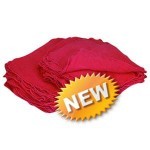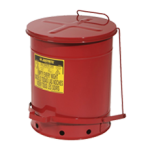In a press release dated July 23, 2013 the USEPA announced a modification of the RCRA regulations to conditionally exclude solvent-contaminated wipes from certain hazardous waste requirements. This long-awaited final rule makes the following changes to the USEPA’s hazardous waste regulations:

- Creates the following new terms and definitions at 40 CFR 260.10:
- No free liquids
- Solvent-contaminated wipes
- Wipe
- Creates a new conditional exclusion from definition as a solid waste at 40 CFR 261.4(a)(26): Solvent-Contaminated Wipes Sent for Cleaning and Reuse
- Creates a new conditional exclusion from definition as a hazardous waste at 40 CFR 261.4(b)(18): Solvent-Contaminated Wipes, Except Wipes with Trichloroethylene, Sent for Disposal
The effective date for this regulation – ie. the date it becomes an enforceable USEPA regulation – is set as six (6) months from the date of its publication in the Federal Register. It was published in the FR today (July 31, 2013) making it effective on January 31, 2014.
The exclusion is expected to be used by and be a significant cost-savings for thousands of US businesses. To ensure you are one of them, carefully review the regulatory requirements and modify your operations accordingly.
First we’ll start with the new definitions in §260.10:
No free liquids, as used in 40 CFR 261.4(a)(26) and 40 CFR 261.4(b)(18), means that solvent-contaminated wipes may not contain free liquids as determined by Method 9095B (Paint Filter Liquids Test), included in “Test Methods for Evaluating Solid Waste, Physical/Chemical Methods” (EPA Publication SW-846), which is incorporated by reference, and that there is no free liquid in the container holding wipes. No free liquids may also be determined using another standard or test method as defined by an authorized state.
Solvent-contaminated wipe means a wipe that, after use or after cleaning up a spill, either (1) contains one or more of the F001 through F005 solvents listed in 40 CFR 261.31 or the corresponding P- or U- listed solvents found in 40 CFR 261.33; (2) exhibits a hazardous characteristic found in 40 CFR part 261 subpart C when that characteristic results from a solvent listed in 40 CFR part 261; and/or (3) exhibits only the hazardous waste characteristic of ignitability found in 40 CFR 261.21 due to the presence of one or more solvents that are not listed in 40 CFR part 261. Solvent-contaminated wipes that contain listed hazardous waste other than solvents, or exhibit the characteristic of toxicity, corrosivity, or reactivity due to contaminants other than solvents, are not eligible for the exclusions at 40 CFR 261.4(a)(26) and 40 CFR 261.4(b)(18).
Wipe means a woven or non-woven shop towel, rag, pad, or swab made of wood pulp, fabric, cotton, polyester blends, or other material.
The definition of No Free Liquids may mistakenly lead you to believe that any free liquids in a solvent-contaminated wipes container precludes the use of this exclusion; this is not so. The issue of free liquids in the solvent-contaminated wipes container will be addressed later in this article.
To meet the definition and be subject to the exclusion a solvent-contaminated wipe may be either of the following:
- Cleaned and reused after use at an industrial laundry or dry cleaner (hereafter referred to as “reusable wipes”).
- Disposed of after use at a municipal solid waste landfill or a solid waste combustion unit (hereafter referred to as “disposable wipes”).
And a solvent contaminated wipe must be one of the following:
- A wipe containing one or more F001-F005 listed solvents found in §261.31 or the corresponding P- or U-listed solvents found in §261.33, including those listed below in Table 1:
Table 1 – Listed Solvents (from 40 CFR 261) for the Solvent-Contaminated Wipes Conditional Exclusion
Acetone | Isobutyl Alcohol | Benzene |
Methanol | n-Butanol | Methyl Ethyl Ketone |
Chlorobenzene | Methyl Isobutyl Ketone | Creosols |
Methylene Chloride | Cyclohexanone | Tetrachloroethylene |
1,2-Dichlorobenzene | Toluene | Ethyl Acetate |
1,1,2-Trichloroethane | Ethyl Benzene | Trichloroethylene (for reusable wipes only) |
2-Ethoxyethanol | Xylenes |
- A wipe that exhibits a hazardous waste characteristic (Ignitability, Corrosivity, Reactivity, Toxicity) resulting from a solvent listed in Table 1.
- A wipe that exhibits only the hazardous characteristic of Ignitability resulting from a solvent not listed in §261 or Table 1.
| What is an example of a wipe that exhibits only the hazardous characteristic of Ignitability resulting from a solvent not listed in §261?Answer: A wipe contaminated with Isopropyl Alcohol (aka Isopropanol). |
Whether reusable or disposable, a solvent-contaminated wipe must be managed according to specific requirements in order be subject to the exclusion, these include:
- On-site accumulation and off-site transportation must be in closed containers (sealed for off-site transportation) that are capable of containing free liquids, if any are present.

Solvent Contaminated Wipes Must be Kept in a Closed Container - Containers must be labeled: “Excluded Solvent-Contaminated Wipes”.
- On-site accumulation of solvent-contaminated wipes may not exceed 180 days.
- Containers of solvent-contaminated wipes may not contain free liquids at the point of being sent off-site. If present, any free liquids removed from the wipes during its on-site accumulation will need to be managed as a hazardous waste. Free liquids may be present in a solvent-contaminated wipes container for the 180 days that it remains on-site and need not be managed as a distinct wastestream until the point the wipes are shipped off-site for disposal or laundering.
- Generators of solvent-contaminated wipes must maintain records of documents that include:
- Name and address of the laundry, dry cleaner, landfill, or combustion unit.
- Evidence that the 180 day on-site accumulation limit has not been exceeded. This can be accomplished by placing the initial date of accumulation on the container.
- Description of the process the generator is using to meet the “no free liquids” condition.
As noted above, the presence of free liquids in the solvent-contaminated wipes container is not a violation of the regulations. However, the free liquids, if present, must be managed properly when the solvent-contaminated wipes are shipped off-site. To determine if free liquids are present, refer to the definition in §260.10, it references the USEPA standard method to identify the presence of free liquids: the Paint Filter Test; but also allows for use of an alternative method if required by a state that has an authorized hazardous waste program.
There are some differences in the exclusions available for reusable wipes and disposable wipes, they include:
- Reusable wipes may be excluded from the definition of solid waste at 40 CFR 261.4(a)(26), and if so, cannot be a hazardous waste. Whereas a disposable wipe may be excluded from definition as a hazardous waste but remains a solid waste and therefore subject to regulation under RCRA Subtitle D. The management of solid waste under Subtitle D of RCRA is delegated to the individual states; check with your state to confirm management of non-hazardous solid waste.
- Disposable wipes that are contaminated with Trichloroethylene (an F001-F005 listed solvent identified in Table 1) are not eligible for the exclusion. USEPA feels wipes contaminated with Trichloroethylene are not safe for disposal in a municipal solid waste landfill. Therefore, these disposable wipes will need to be managed as a hazardous waste.
- Reusable wipes must go to a laundry or dry cleaner whose wastewater discharge, if any, is regulated under the Clean Water Act. Disposable wipes must go to one of the following:
- A combustor regulated under the Clean Air Act.
- A hazardous waste combustor, boiler, or industrial furnace regulated under RCRA.
- A municipal solid waste landfill or hazardous waste landfill regulated under RCRA.
As a relaxation of the “base” RCRA regulations, states with authorized hazardous waste programs (all but Alaska, Iowa, Puerto Rico, and Indian Country) are not required to incorporate this Final Rule into their state regulations. However, states are not allowed to maintain regulations that are less stringent than the Federal. Further, the USEPA, while not requiring nation-wide implementation of this Final Rule, is strongly encouraging states to implement it in its current form. Therefore, it is likely that most solvent-contaminated wipe generators will see a change to their state regulations to reflect this Final Rule. Since the changes are not that different than the various state program already in place, it is expected that most state regulations will be similar to this Final Rule. In sum, be sure to check with your state before to determine the proper management of your solvent-contaminated wipes.
Much more information about the Final Rule can be found at the following sources:
- Solvent-Contaminated Wipes Rulemaking FAQ’s
- Solvent-Contaminated Wipes Management Summary Chart
- Pre-Publication Version of the Signed Final Rule

Annual training for facility personnel is required for Large Quantity Generators of hazardous waste
Changes to the regulations like this force me to change my Hazardous Waste Personnel (RCRA) Training presentations! Make sure you stay on top of the latest regulatory changes and get the required training, please contact me to schedule your USEPA Hazardous Waste Training.


